(完整word版)国际企业管理答案
(完整word版)企业战略管理试题及答案
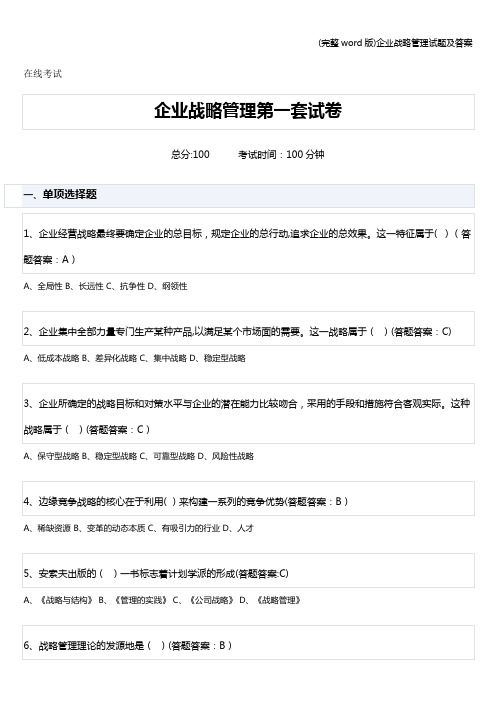
在线考试总分:100 考试时间:100分钟A、全局性B、长远性C、抗争性D、纲领性A、低成本战略B、差异化战略C、集中战略D、稳定型战略A、保守型战略B、稳定型战略C、可靠型战略D、风险性战略A、稀缺资源B、变革的动态本质C、有吸引力的行业D、人才A、《战略与结构》B、《管理的实践》C、《公司战略》D、《战略管理》A、英国B、美国C、日本D、中国A、总体战略B、职能战略C、经营单位战略D、竞争战略A、政治环境分析B、经济环境分析C、社会文化分析D、自然环境分析A、行业技术状况分析B、行业寿命周期分析C、行业规模分析D、行业内战略集团分析A、政治环境分析B、经济环境分析C、社会文化分析D、技术环境分析A、完全垄断B、垄断竞争C、寡头垄断D、完全竞争A、投入期B、成长期C、成熟期D、衰退期A、购买者讨价还价的能力B、替代品C、互补品D、现有企业的竞争A、人力资源(员工素质、团队精神)B、财务资源C、技术资源(版权、专利)D、企业品牌形象A、稳定的高利润B、稳定的低利润C、高利润高风险D、低利润低风险A、投入期B、成长期C、成熟期D、衰退期A、无形资源、有形资源B、有形资源、无形资源C、资源、能力D、能力、资源A、良好的工作能力B、良好的组织能力C、良好的领导能力D、良好的记忆与学习的能力A、核心技术能力、科技B、组织文化、学习型C、人力资源、组织能力D、业务营运、服务A、系统性思维B、封闭性思维C、超前性思维D、创造性思维E、单向性思维A、政治制度B、法律制度C、文化环境D、人口环境E、经济环境A、投入期B、成长期C、成熟期D、衰退期E、转移期A、规模经济B、资源条件C、产品差异优势D、资金需求E、原有企业对新进入者的态度A、难以模仿性B、稀有性C、获利性D、持久性E、无形性A、财务能力B、营销能力C、生产能力D、成长性能力E、流动性能力A、企业技术资源B、信息资源C、信誉资源D、关系资源E、人力资源A、是B、否A、是B、否A、是B、否A、是B、否A、是B、否A、是B、否A、是B、否A、是B、否A、是B、否A、是B、否A、是B、否A、是B、否A、是B、否A、是B、否A、是B、否A、是B、否A、是B、否A、是B、否A、是B、否A、是B、否A、是B、否A、是B、否A、是B、否A、是B、否在线考试总分:100 考试时间:100分钟A、适应性B、更新性C、约束力D、鼓励性A、动态平衡B、定量落实C、评价标准D、激励鼓动A、企业使命B、企业宗旨C、企业哲学D、企业目标A、企业文化B、企业宗旨C、企业哲学D、企业使命A、是固定不变的B、不是固定不变的C、可能是固定不变的D、随时变化A、实现规模经济B、实现范围经济C、实现外部经济D、获得内部经济A、买方的价值链与价值信号标准B、企业自身以实施差异化在价值链的优势C、企业自身对差异化成本的控制D、竞争者中有无这种差异化A、低成本战略B、差异化战略C、集中化战略D、一体化战略A、产品开发战略B、市场开发战略C、市场渗透战略D、一体化战略A、尽量减少股东的损失B、降低成本和投资C、调整企业组织D、减少使用的销售渠道A、信息不准确的成本B、业务协同的成本C、信息不及时的成本D、协调控制经营单位的成本A、国际本土化战略B、全球化战略C、跨国战略D、国际多元化战略A、国际本土化战略B、全球化战略C、跨国战略D、国际多元化战略A、全球化战略B、电子商务战略C、国际化战略D、一体化战略A、数码技术B、网络信息技术C、通讯技术D、视频技术A、基本信念B、战略目标C、价值观念D、经营领域E、行为准则A、企业经营哲学B、企业经营范围C、企业经营目的D、企业成长方向E、企业经营规模A、明确具体B、有科学依据C、目标水准要高D、富有挑战性E、突出重点A、大规模、高效率的生产B、降低经验成本C、成本与间接费用的控制D、各环节成本最小化E、容易取得资源A、新加入者的模仿、定点超越等B、技术进步降低企业资源的利用C、丧失对市场变化的敏锐洞察D、受外部环境的影响E、人力资源流失A、面临实行低成本战略企业的威胁B、利润额下滑C、买方需要的差异化程度下降事业的风险D、模仿者的威胁E、服务水平下降A、钢铁厂自己轧制各种型材,并制成各种成品以销售B、钢铁厂自己获取矿石生产场C、钢铁厂自己建设发电站D、钢铁厂自己建设运输物流系统E、钢铁厂自己投资于钢铁交易市场A、技术的匹配性B、运营的匹配性C、与销售相关的匹配性D、与顾客相关的匹配性E、管理的匹配性A、发挥协同效应B、发掘利用目标公司的潜在价值C、目标水准要高D、降低进入壁垒和发展风险E、应对产业内部竞争A、是B、否A、是B、否A、是B、否A、是B、否A、是B、否A、是B、否A、是B、否A、是B、否A、是B、否A、是B、否A、是B、否A、是B、否A、是B、否A、是B、否A、是B、否A、是B、否A、是B、否A、是B、否A、是B、否A、是B、否A、是B、否A、是B、否A、是B、否A、是B、否A、是B、否A、是B、否在线考试总分:100 考试时间:100分钟A、进取象限B、进取象限C、防御象限D、竞争象限A、定性和定量方法B、直觉与数学方法C、德尔菲技术和时间序列分析法D、专家决策和回归分析方法A、收获型和一体化战略B、市场渗透和一体化战略C、市场渗透和产品开发D、产品开发和收获型战略A、产业优势和市场增长B、竞争地位和环境优势C、市场增长和环境优势D、竞争地位和市场增长A、BCG矩阵B、P/MEP矩阵C、QSPM矩阵D、GS矩阵A、反映生产方式的最优程度B、反映战略的最优程度C、反映销售业绩的最优程度D、反映产品质量的最优程度A、战略变革B、战略实施C、战略分解D、战略选择A、横向展开B、水平展开C、交叉展开D、纵向展开A、公司治理B、公司使命C、公司制度D、公司文化A、让战略体现出价值B、领导要高瞻远瞩C、注重引导D、注意清除战略推行过程中的障碍A、让战略体现出价值B、领导要高瞻远瞩C、注重引导D、注意清除战略推行过程中的障碍A、战略分析B、战略控制C、战略选择D、战略变革A、事前控制B、事中控制C、开关型控制D、事后控制A、生产控制B、财务控制C、营销控制D、人力控制A、市场份额B、客户满意程度C、客户保持率D、销售净利率A、学习与成长B、业务流程C、顾客角度D、财务角度A、职责分离B、完整和准确的记录保存C、资产的实物安全D、授权的层级A、战略变革的动因B、战略变革的类型C、战略变革的主导思维逻辑D、战略变革方式A、战略渐变式B、战略连变式C、战略突变式D、战略跳变式A、有利于维持组织的稳定性B、进度容易控制C、不会遇到太大阻力D、能够以较快的速度达到目的A、成本效益原理B、差异化竞争优势理论C、理查德·达维尼的竞争优势理论D、熊皮特的“创造性破坏"理论A、扩大经济规模和市场机会B、重点投资,提高市场占有率C、应减少批量,逐渐撤退D、将剩余资源向其它产品转移E、将瘦狗产品与其它事业部合并,统一管理A、B2CB、B2BC、B2MD、C2CE、B2GA、文化分解B、时间分解C、物质分解D、空间分解E、化学分解A、战略选择决定了组织结构所需要采取的形式B、特定战略与组织结构结合才能推动战略目标的实现C、组织结构会限制战略的选择和执行D、战略决定组织结构的类型,组织结构服从于企业战略E、组织结构如果没有重大改变,组织战略的实质也必然要改良A、设定绩效标准B、绩效监控与偏差评估C、设计并采取纠正偏差的措施D、监控外部环境的关键因素E、激励战略控制的执行主体A、直接领导B、自我调节C、共同愿景D、战略技术E、战略要求A、企业战略内容方面的变革B、企业竞争优势方面的变革C、企业组织层面的变化D、企业组织资源方面的变革E、企业产品结构方面的变革A、企业家精神是驱动变革的决定性动力B、共同愿景与使命是企业变革的驱动力C、高效的领导团队是变革成功的保证D、创建学习型组织为变革提供持续动力E、树立危机意识是战略变革的前提A、是B、否A、是B、否A、是B、否A、是B、否A、是B、否A、是B、否A、是B、否A、是B、否A、是B、否A、是B、否A、是B、否A、是B、否A、是B、否A、是B、否A、是B、否A、是B、否A、是B、否A、是B、否A、是B、否A、是B、否A、是B、否。
(完整word版)管理信息系统练习(答案)
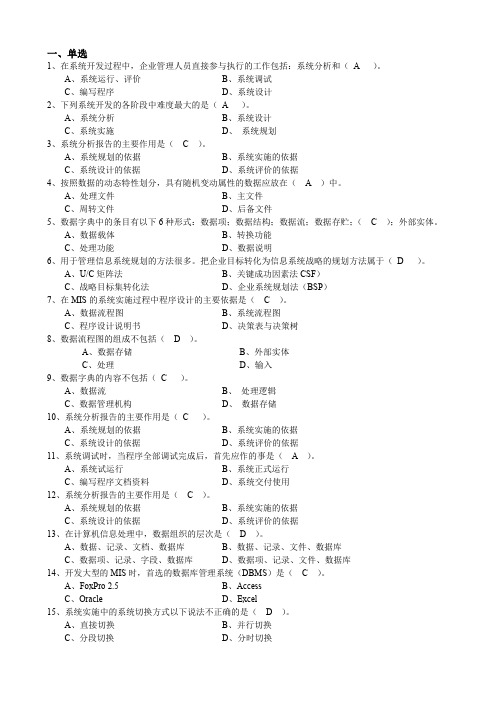
一、单选1、在系统开发过程中,企业管理人员直接参与执行的工作包括:系统分析和(A )。
A、系统运行、评价B、系统调试C、编写程序D、系统设计2、下列系统开发的各阶段中难度最大的是(A )。
A、系统分析B、系统设计C、系统实施D、系统规划3、系统分析报告的主要作用是( C )。
A、系统规划的依据B、系统实施的依据C、系统设计的依据D、系统评价的依据4、按照数据的动态特性划分,具有随机变动属性的数据应放在( A )中。
A、处理文件B、主文件C、周转文件D、后备文件5、数据字典中的条目有以下6种形式:数据项;数据结构;数据流;数据存贮;( C );外部实体。
A、数据载体B、转换功能C、处理功能D、数据说明6、用于管理信息系统规划的方法很多。
把企业目标转化为信息系统战略的规划方法属于(D )。
A、U/C矩阵法B、关键成功因素法CSF)C、战略目标集转化法D、企业系统规划法(BSP)7、在MIS的系统实施过程中程序设计的主要依据是( C )。
A、数据流程图B、系统流程图C、程序设计说明书D、决策表与决策树8、数据流程图的组成不包括( D )。
A、数据存储B、外部实体C、处理D、输入9、数据字典的内容不包括(C )。
A、数据流B、处理逻辑C、数据管理机构D、数据存储10、系统分析报告的主要作用是(C )。
A、系统规划的依据B、系统实施的依据C、系统设计的依据D、系统评价的依据11、系统调试时,当程序全部调试完成后,首先应作的事是( A )。
A、系统试运行B、系统正式运行C、编写程序文档资料D、系统交付使用12、系统分析报告的主要作用是( C )。
A、系统规划的依据B、系统实施的依据C、系统设计的依据D、系统评价的依据13、在计算机信息处理中,数据组织的层次是( D )。
A、数据、记录、文档、数据库B、数据、记录、文件、数据库C、数据项、记录、字段、数据库D、数据项、记录、文件、数据库14、开发大型的MIS时,首选的数据库管理系统(DBMS)是( C )。
(完整word版)管理学练习题及答案(周三多)
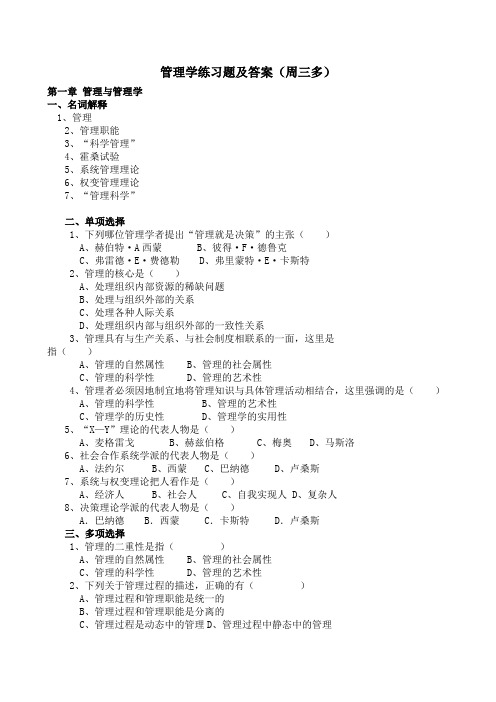
管理学练习题及答案(周三多)第一章管理与管理学一、名词解释1、管理2、管理职能3、“科学管理”4、霍桑试验5、系统管理理论6、权变管理理论7、“管理科学”二、单项选择1、下列哪位管理学者提出“管理就是决策”的主张()A、赫伯特·A西蒙B、彼得·F·德鲁克C、弗雷德·E·费德勒D、弗里蒙特·E·卡斯特2、管理的核心是()A、处理组织内部资源的稀缺问题B、处理与组织外部的关系C、处理各种人际关系D、处理组织内部与组织外部的一致性关系3、管理具有与生产关系、与社会制度相联系的一面,这里是指()A、管理的自然属性B、管理的社会属性C、管理的科学性D、管理的艺术性4、管理者必须因地制宜地将管理知识与具体管理活动相结合,这里强调的是()A、管理的科学性B、管理的艺术性C、管理学的历史性D、管理学的实用性5、“X—Y”理论的代表人物是()A、麦格雷戈B、赫兹伯格C、梅奥D、马斯洛6、社会合作系统学派的代表人物是()A、法约尔B、西蒙C、巴纳德D、卢桑斯7、系统与权变理论把人看作是()A、经济人B、社会人C、自我实现人D、复杂人8、决策理论学派的代表人物是()A.巴纳德 B.西蒙 C.卡斯特 D.卢桑斯三、多项选择1、管理的二重性是指()A、管理的自然属性B、管理的社会属性C、管理的科学性D、管理的艺术性2、下列关于管理过程的描述,正确的有()A、管理过程和管理职能是统一的B、管理过程和管理职能是分离的C、管理过程是动态中的管理D、管理过程中静态中的管理E、管理过程也是信息变换的过程3、管理学具有以下特征:()A、一般性B、综合性C、历史性D、实用性E、艺术性4、从科学的定义上讲,存在管理必须具备以下条件:()A、必须是两个人以上的集体活动B、必须是具有盈利动机的集体活动C、必须是正式组织D、必须是非正式组织E、必须具有一致认可的、自觉的目标5、赫兹伯格理论中的“双因素”是指()A.保健 B.激励 C.X理论 D.Y理论6、以下哪些内容是法约尔提出的管理原则()A.统一指挥 B.统一领导C.职能管理 D.人员的团结7、“行为科学”的代表人物是()A.德鲁克 B.马斯洛 C.麦格雷戈 D.西蒙8、古典管理理论的代表人物是()A.泰罗 B.法约尔 C.梅奥 D.李嘉图四、填空1、管理二重性是指和。
(完整word版)实用管理基础试题及参考答案.7

《实用管理基础》试题及参考答案2015。
7•《实用管理基础》试题及参考答案2015。
7一、单项选择(请从四个备选答案中选择一个正确答案的字母,填入括号中。
每小题2分,共20分)1.孟子曰:"凡事预则立,不预则废”。
指的是管理的()职能的重要性.A.计划B.决策C.组织D.协调2.理想的行政组织体系理论,是由马克斯·韦伯提出来的。
其中"理想的”是指现代社会()组织形式。
A.最有效和合理的B.最符合需要的C. 最经济和合理的D.最先进科学的3.公司政策规定工作人员享有假期,为实施这项政策公司编制了度假时间表,制订了假期工资率、支付办法,以及申请度假的详细说明,这属于( ).A。
策略B.程序C。
规划D。
规则4.例外决策,具有极大偶然性、随机性,又无先例可循且具有大量不确定性的决策活动,其方法和步骤也是难以程序化、标准化,不能重复使用的.这类决策又称为( )。
A.风险型决策B.不确定型决策C。
战略决策D.非程序化决策5.为了达到某些特定目标,在分工合作基础上构成的人的集合。
这是()。
A。
组织的一般含义B.组织的动态含义C. 组织的静态含义D.组织的管理学含义6.各种标准化制度,例会制度,现场办公等属于( )。
A. 人际关系协调方式B.结构协调方式C. 制度协调方式D.相互调整方式7.当组织的外部环境变化不大时,企业组织结构可以体现较强的( ).A.弹性B.刚性C。
不确定性D,柔性8.企业组织内部管理人员的选聘主要来自内部和外部两个渠道。
一般而言,()的选聘多采用外源渠道。
A。
基层管理者B.中层管理者C。
高层管理者D.普通管理者9.()认为人的需要由低级向高级分为五个层次,即生理的需要、保障或安全的需要、归属或承认的需要、尊重的需要、自我实现的需要。
A.需要层次理论B.双因素理论C。
成就需要理论D.期望理论10.成本控制的主要对象是管理过程中的().A。
作业层B.人C. 财D.物二、判断并改错(下列各题有对有错,对的打√;错的打X,并写出正确答案。
(完整word版)IDC考试答案
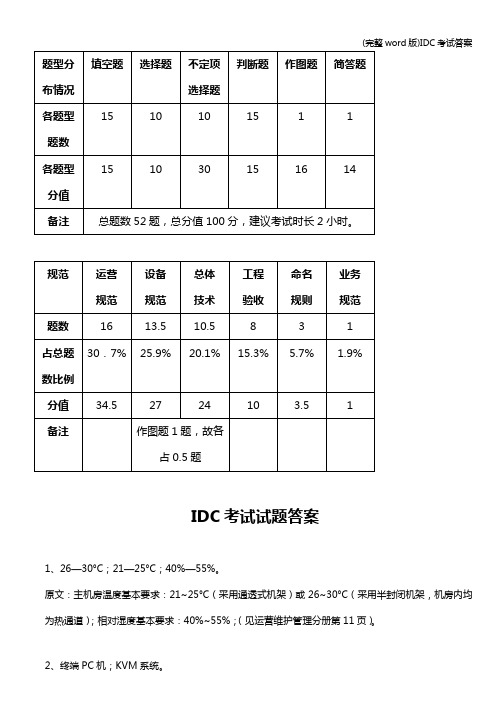
IDC考试试题答案1、26—30°C;21—25°C;40%—55%。
原文:主机房温度基本要求:21~25°C(采用通透式机架)或26~30°C(采用半封闭机架,机房内均为热通道);相对湿度基本要求:40%~55%;(见运营维护管理分册第11页)。
2、终端PC机;KVM系统。
原文:定期检查客户工作区操作终端的运行状况,包括对终端PC机和KVM系统的检查;(见运营维护管理分册第15页)。
3、帐号模拟破解测试。
原文:安全管理人员应定期进行帐号模拟破解测试,如发现脆弱性密码要及时通知使用者进行密码修改;(见运营维护管理分册第16页)。
4、私有IP地址。
原文:根据客户的实际使用情况合理划分VLAN,对网管及后台管理系统必须使用私有IP地址,防范来自IDC内部的攻击。
(见运营维护管理分册第21页)。
5、主机系统本身;防火墙系统;攻击数据源。
原文:如果安全问题属于拒绝服务攻击,应判断拒绝服务攻击的类型,关闭相应非业务端口或调整主机系统本身和防火墙系统的设置,尽量减小拒绝服务攻击的危害。
同时对攻击数据源进行跟踪;(见运营维护管理分册第36页)。
6、双链路冗余;全网状冗余;原文:网络应采用双设备的冗余硬件设计,上连链路采用双链路冗余网络结构或全网状冗余网络结构。
(见设备规范第11页)。
7、加密VPN原文:管理员从外部网络接入IDC管理维护区必须采用加密VPN接入,如IPsec VPN、SSL VPN等;(见设备规范第45页)8单链路/多链路互连;动态路由方式原文:汇聚层采用双机冗余结构,双机之间采用单链路/多链路互连。
设备之间的路由信息共享宜采用动态路由方式。
(见总体技术第12页)。
9、本地验证;Radius原文:防火墙应支持对本地的安全管理特性,支持对访问防火墙本地用户进行验证,验证协议需要支持本地验证和Radius。
(见总体技术第24页)。
10、50;70%原文:IDC管理员或客户运维人员在IDC运维管理管理平台上进行操作时,支持的并发客户端数量大于50个;网管服务器CPU忙时利用率平均不超过70%。
(完整word版)国际经济学测试题答案
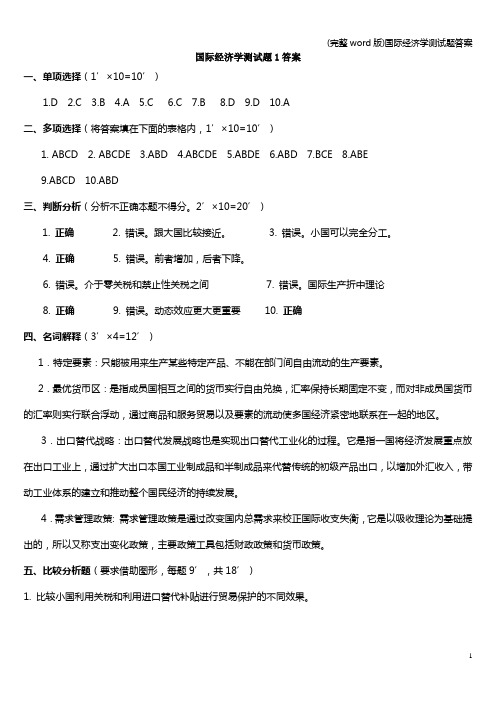
国际经济学测试题1答案一、单项选择(1’×10=10’)1.D2.C3.B4.A5.C6.C7.B8.D9.D 10.A二、多项选择(将答案填在下面的表格内,1’×10=10’)1. ABCD2. ABCDE3.ABD4.ABCDE5.ABDE6.ABD7.BCE8.ABE9.ABCD 10.ABD三、判断分析(分析不正确本题不得分。
2’×10=20’)1. 正确2. 错误。
跟大国比较接近。
3. 错误。
小国可以完全分工。
4. 正确5. 错误。
前者增加,后者下降。
6. 错误。
介于零关税和禁止性关税之间7. 错误。
国际生产折中理论8. 正确9. 错误。
动态效应更大更重要10. 正确四、名词解释(3’×4=12’)1.特定要素:只能被用来生产某些特定产品、不能在部门间自由流动的生产要素。
2.最优货币区:是指成员国相互之间的货币实行自由兑换,汇率保持长期固定不变,而对非成员国货币的汇率则实行联合浮动,通过商品和服务贸易以及要素的流动使多国经济紧密地联系在一起的地区。
3.出口替代战略:出口替代发展战略也是实现出口替代工业化的过程。
它是指一国将经济发展重点放在出口工业上,通过扩大出口本国工业制成品和半制成品来代替传统的初级产品出口,以增加外汇收入,带动工业体系的建立和推动整个国民经济的持续发展。
4.需求管理政策: 需求管理政策是通过改变国内总需求来校正国际收支失衡,它是以吸收理论为基础提出的,所以又称支出变化政策,主要政策工具包括财政政策和货币政策。
五、比较分析题(要求借助图形,每题9’,共18’)1. 比较小国利用关税和利用进口替代补贴进行贸易保护的不同效果。
征收关税之后,该国的总福利水平下降了:消费者剩余损失了(a+b+c+d),其中a被生产者所得,c为政府财政收入所得,但尚有b和d的损失,国内没有任何人能得到相应的补偿。
这是由于关税使本国的生产资源从效率较高的部门转移到了效率较低的部门,即一国的生产资源向没有比较优势的进口竞争部门集中,因此造成了国民福利净损失。
(完整word版)国际投资学第三章国际投资环境课后习题答案(个人总结)

第三章国际投资环境1. 名词解释国际投资环境:影响国际投资的各种自然因素、经济因素、政治因素、社会因素和法律因素相互依赖、相互完善、相互制约所形成的的矛盾统一体。
硬环境:能影响投资的外部物质条件。
软环境:能影响国际直接投资的各种非物质形态的因素。
冷热比较分析法:从政治稳定性、市场机会、经济发展与成就、文化一元化等“热”因素和法令障碍、实质障碍、地理与文化差异等冷因素共7各方面对各国投资环境进行综合比较分析。
2.简述国际直接投资环境的重要性及其决定因素重要性:国际直接投资环境的优劣直接决定了一国对外资吸引力的大小。
决定因素:经济环境是最直接、最基本的因素。
3。
试总结各种国际投资环境评估方法的基本思路和共性基本思路和共性是将总投资环境分解为若干具体指标,然后再综合评判。
4. 案例分析分别运用等级尺度法和要素评价分类法对英国的投资环境进行计分和评价等级尺度法:1.货币稳定性(4—20分)2.近五年通货膨胀率(2—14分)3.资本外调(0-12分)4。
外商股权(0—12分)5.外国企业与本地企业之间的差别待遇和控制(0-12分)6.政治稳定性(0—12分)7.当地资本供应能力(0-10分)8。
给予关税保护的态度(2—8分)要素评价法:I=AE/CF(B+D+G+H)+x 投资环境激励系数(A) 城市规划完善度因子(B)利税因子(C)劳动生产率因子(D)地区基础因子(E)效率因子(F) 市场因子(G) 管理权因子(H)5。
试结合本章专栏3—1和专栏3-3,分析我国改善投资环境的重点和具体措施.改善投资环境的重点是改善软环境和社会因素中的价值观念、教育水平、社会心理与习惯.具体措施是降低贸易壁垒、提高私有财产保护程度、降低企业运行障碍、提高政府清廉程度、提高经济自由程度和提高法律完善程度。
本章小结国际投资环境是指影响国际投资的各种因素相互依赖、相互完善、相互制约所形成的矛盾统一体,国际直接投资环境的优劣直接决定了一国对外资吸引力的大小。
(完整word版)国际财务管理课后习题答案chapter9
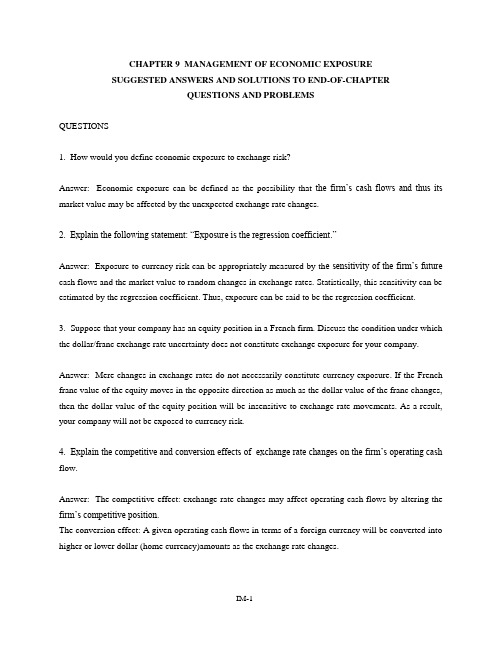
CHAPTER 9 MANAGEMENT OF ECONOMIC EXPOSURESUGGESTED ANSWERS AND SOLUTIONS TO END-OF-CHAPTERQUESTIONS AND PROBLEMSQUESTIONS1. How would you define economic exposure to exchange risk?Answer: Economic exposure can be defined as the possibility that the firm’s cash flows and thus its market value may be affected by the unexpected exchange rate changes.2. Explain the following statement: “Exposure is the regression coefficient.”Answer: Exposure to currency risk can be appropriately measured by th e sensitivity of the firm’s future cash flows and the market value to random changes in exchange rates. Statistically, this sensitivity can be estimated by the regression coefficient. Thus, exposure can be said to be the regression coefficient.3. Suppose that your company has an equity position in a French firm. Discuss the condition under which the dollar/franc exchange rate uncertainty does not constitute exchange exposure for your company.Answer: Mere changes in exchange rates do not necessarily constitute currency exposure. If the French franc value of the equity moves in the opposite direction as much as the dollar value of the franc changes, then the dollar value of the equity position will be insensitive to exchange rate movements. As a result, your company will not be exposed to currency risk.4. Explain the competitive and conversion effects of exchange rate changes on the firm’s operating cash flow.Answer: The competitive effect: exchange rate changes may affect operating cash flows by altering the firm’s competitive position.The conversion effect: A given operating cash flows in terms of a foreign currency will be converted into higher or lower dollar (home currency)amounts as the exchange rate changes.5. Discuss the determinants of operating exposure.Answer: The main determinants of a firm’s operating exposure are (1) the structure of the markets in which the firm sources its inputs, such as labor and materials, and sells its products, and (2) the firm’s ability to mitigate the effect of exchange rate changes by adjusting its markets, product mix, and sourcing.6. Discuss the implications of purchasing power parity for operating exposure.Answer: If the exchange rate changes are matched by the inflation rate differential between countries, firms’ competitive positions will not be altered by exchange rate changes. Firms are not subject to operating exposure.7. General Motors exports cars to Spain but the strong dollar against the peseta hurts sales of GM cars in Spain. In the Spanish market, GM faces competition from the Italian and French car makers, such as Fiat and Renault, whose currencies remain stable relative to the peseta. What kind of measures would you recommend so that GM can maintain its market share in Spain.Answer: Possible measures that GM can take include: (1) diversify the market; try to market the cars not just in Spain and other European countries but also in, say, Asia; (2) locate production facilities in Spain and source inputs locally; (3) locate production facilities, say, in Mexico where production costs are low and export to Spain from Mexico.8. What are the advantages and disadvantages of financial hedging of the firm’s operating exposure vis-à-vis operational hedges (such as relocating manufacturing site)?Answer: Financial hedging can be implemented quickly with relatively low costs, but it is difficult to hedge against long-term, real exposure with financial contracts. On the other hand, operational hedges are costly, time-consuming, and not easily reversible.9. Discuss the advantages and disadvantages of maintaining multiple manufacturing sites as a hedge against exchange rate exposure.Answer: To establish multiple manufacturing sites can be effective in managing exchange risk exposure, but it can be costly because the firm may not be able to take advantage of the economy of scale.10. Evaluate the following statement: “A firm can reduce its currency exposure by diversifying across different business lines.”Answer: Conglomerate expansion may be too costly as a means of hedging exchange risk exposure. Investment in a different line of business must be made based on its own merit.11. The exchange rate uncertainty may not necessarily mean that firms face exchange risk exposure. Explain why this may be the case.Answer: A firm can have a natural hedging position due to, for example, diversified markets, flexible sourcing capabilities, etc. In addition, to the extent that the PPP holds, nominal exchange rate changes do not influenc e firms’ competitive positions. Under these circumstances, firms do not need to worry about exchange risk exposure.PROBLEMS1. Suppose that you hold a piece of land in the City of London that you may want to sell in one year. As a U.S. resident, you are concerned with the dollar value of the land. Assume that, if the British economy booms in the future, the land will be worth £2,000 and one British pound will be worth $1.40. If the British economy slows down, on the other hand, the land will be worth less, i.e., £1,500, but the pound will be stronger, i.e., $1.50/£. You feel that the British economy will experience a boom with a 60% probability and a slow-down with a 40% probability.(a) Estimate your exposure b to the exchange risk.(b) Compute the variance of the dollar value of your property that is attributable to the exchange rate uncertainty.(c) Discuss how you can hedge your exchange risk exposure and also examine the consequences of hedging.Solution: (a) Let us compute the necessary parameter values:E(P) = (.6)($2800)+(.4)($2250) = $1680+$900 = $2,580E(S) = (.6)(1.40)+(.4)(1.5) = 0.84+0.60 = $1.44Var(S) = (.6)(1.40-1.44)2 + (.4)(1.50-1.44)2= .00096+.00144 = .0024.Cov(P,S) = (.6)(2800-2580)(1.4-1.44)+(.4)(2250-2580)(1.5-1.44)= -5.28-7.92 = -13.20b = Cov(P,S)/Var(S) = -13.20/.0024 = -£5,500.You have a negative exposure! As the pound gets stronger (weaker) against the dollar, the dollar value of your British holding goes down (up).(b) b2Var(S) = (-5500)2(.0024) =72,600($)2(c) Buy £5,500 forward. By doing so, you can eliminate the volatility of the dollar value of your British asset that is due to the exchange rate volatility.2. A U.S. firm holds an asset in France and faces the following scenario:In the above table, P* is the euro price of the asset held by the U.S. firm and P is the dollar price of the asset.(a) Compute the exchange exposure faced by the U.S. firm.(b) What is the variance of the dollar price of this asset if the U.S. firm remains unhedged against thisexposure?(c) If the U.S. firm hedges against this exposure using the forward contract, what is the variance of thedollar value of the hedged position?Solution: (a)E(S) = .25(1.20 +1.10+1.00+0.90) = $1.05/€E(P) = .25(1,800+1,540+1,300 +1,080) = $1,430Var(S) = .25[(1.20-1.05)2 +(1.10-1.05)2+(1.00-1.05)2+(0.90-1.05)2]= .0125Cov(P,S) = .25[(1,800-1,430)(1.20-1.05) + (1,540-1,430)(1.10-1.05)(1,300-1,430)(1.00-1.05) + (1,080-1,430)(0.90-1.05)]= 30b = Cov(P,S)/Var(S) = 30/0.0125 = €2,400.(b) Var(P) = .25[(1,800-1,430)2+(1,540-1,430)2+(1,300-1,430)2+(1,080-1,430)2]= 72,100($)2.(c) Var(P) - b2Var(S) = 72,100 - (2,400)2(0.0125) = 100($)2.This means that most of the volatility of the dollar value of the French asset can be removed by hedging exchange risk. The hedging can be achieved by selling €2,400 forward.MINI CASE: ECONOMIC EXPOSURE OF ALBION COMPUTERS PLCConsider Case 3 of Albion Computers PLC discussed in the chapter. Now, assume that the pound is expected to depreciate to $1.50 from the current level of $1.60 per pound. This implies that the pound cost of the imported part, i.e., Intel’s microprocessors, is £341 (=$512/$1.50). Other variables, such as the unit sales volume and the U.K. inflation rate, remain the same as in Case 3.(a) Compute the projected annual cash flow in dollars.(b) Compute the projected operating gains/losses over the four-year horizon as the discounted present value of change in cash flows, which is due to the pound depreciation, from the benchmark case presented in Exhibit 12.4.(c) What actions, if any, can Albion take to mitigate the projected operating losses due to the pound depreciation?Suggested Solution to Economic Exposure of Albion Computers PLCa) The projected annual cash flow can be computed as follows:______________________________________________________Sales (40,000 units at £1,080/unit) £43,200,000Variable costs (40,000 units at £697/unit) £27,880,000Fixed overhead costs 4,000,000Depreciation allowances 1,000,000Net profit before tax £15,315,000Income tax (50%) 7,657,500Profit after tax 7,657,500Add back depreciation 1,000,000Operating cash flow in pounds £8,657,500Operating cash flow in dollars $12,986,250______________________________________________________b) ______________________________________________________Benchmark CurrentVariables Case Case______________________________________________________Exchange rate ($/£) 1.60 1.50Unit variable cost (£) 650 697Unit sales price (£) 1,000 1,080Sales volume (units) 50,000 40,000Annual cash flow (£) 7,250,000 8,657,500Annual cash flow ($) 11,600,000 12,986,250Four-year present value ($) 33,118,000 37,076,946Operating gains/losses ($) 3,958,946______________________________________________________c) In this case, Albion actually can expect to realize exchange gains, rather than losses. This is mainly due to the fact that while the selling price appreciates by 8% in the U.K. market, the variable cost of imported input increased by about 6.25%. Albion may choose not to do anything.。
完整word版,企业战略管理考试参考案例分析答案

三、案例分析题案例一泛美公司的陨落(一)案情1.泛美航空公司是美国境外的一家航线最广、历史最久的航空公司,也是美国国家航运业的化身。
经过50多年的发展,至1980年初已成为全美第三大航空公司。
1927年,美国的航空业还处于初创时期。
这一年泛美航空公司创建。
30年代初,特里普为美国首次开通了横越太平洋的航线,泛美从此声名鹊起。
到40年代后期,泛美已经成为世界上最大的航空公司,具备了全球航运的能力。
第二次世界大战期间,泛美与政府间合作密切,取得了迅速的发展。
1980年,泛美航空公司进行技术改造,淘汰老旧费油的20架B707客机,选择洛克希德制造的L1101-500型宽体客机。
但就在此时,与波音707性能相似,但成本更低的新型飞机纷纷上市,如麦道公司的MD80、波音公司的波音757、波音B767等。
相形之下,11101—500型飞机的单位飞行成本,都明显比新机种高得多,泛美公司为此后悔不迭。
为了摆脱困境,泛美公司不得不抛售一些贵重的非空运财产。
但尽管采取了“拆东墙补西墙”的办法,在1988年美国8家最大的民航公司排名中,泛美仍位居最后。
1990年7月开始的美国经济衰退和接着爆发的海湾战争,使所有的美国航空公司生意清淡。
泛美公司更是捉襟见肘,于1991年12月4日宣告破产,成为该年倒闭的第三个美国大民航公司。
问题:(1)泛美公司的陨落原因是什么?(2)对你有何启示?(二)参考答案:(1)陨落原因:主要是对环境缺少战略分析,对PEST分析预测失误。
一是对市场需求估计不足,忽视了成本因素,造成技术改造决策选择失误。
二是美国处于经济衰退期,市场萧条。
三是在企业快速成长时,忘记了可能存在的财务危机。
(12分)(2)启示:首先,对市场变动趋势反映迟钝,只凭借主观的感觉作出决策,最终必然自食其果。
其次,战略方案的选择对企业的成长是非常重要的。
最后,当战略执行中发生偏差时,必须进行果断的战略调整。
(8分)案例二宜家出走马甸变脸(一)案情宜家在马甸15000平方米的店面,创造出5.4亿元/年的销售额。
(精校版)《管理学》(周三多主编,第五版)习题及答案1
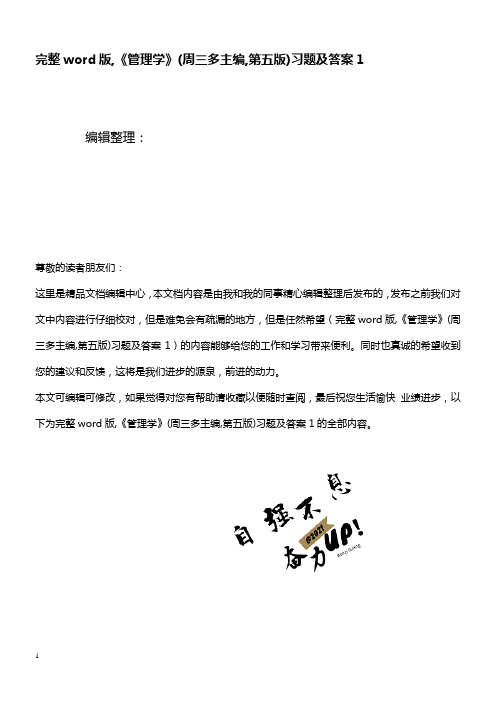
完整word版,《管理学》(周三多主编,第五版)习题及答案1编辑整理:尊敬的读者朋友们:这里是精品文档编辑中心,本文档内容是由我和我的同事精心编辑整理后发布的,发布之前我们对文中内容进行仔细校对,但是难免会有疏漏的地方,但是任然希望(完整word版,《管理学》(周三多主编,第五版)习题及答案1)的内容能够给您的工作和学习带来便利。
同时也真诚的希望收到您的建议和反馈,这将是我们进步的源泉,前进的动力。
本文可编辑可修改,如果觉得对您有帮助请收藏以便随时查阅,最后祝您生活愉快业绩进步,以下为完整word版,《管理学》(周三多主编,第五版)习题及答案1的全部内容。
第一章管理与管理学一、填充题1、许多新的管理理论和管理实践已经一再证明:______、______、______、______、______, 这五种职能是一切管理活动最基本的职能。
[答案]教材P12(计划、组织、领导、控制、创新)2、根据亨利·明茨伯格的一项被广为引用的研究,管理者扮演着十种角色,可归为______、______、______三大类。
[答案]教材P21(人际角色、信息角色、决策角色)3、管理二重性指的是管理既具有______属性,又具有______属性。
[答案]P15—17(自然、社会)4、管理学是以各种管理工作中普遍适用的______和______作为研究对象的.[答案]教材P30(原理、方法)二、选择题1、在同不合作的供应商进行谈判的时候,管理者扮演的是__B__。
(教材P23)A.企业家角色 B.干扰应对者角色 C.资源分配者2、著名的霍桑研究就是采用__B___研究管理中人际关系的成功例子。
(教材P32)A.归纳法B.试验法 C.演绎法3、田力是某大型企业集团的总裁助理,年富力强,在助理岗位上工作得十分出色,他最近被任命为集团销售总公司的总经理,从而由一个参谋人员变成了独立部门的负责人。
下面是田力最近参与的几项活动,你认为这其中的哪一项几乎与他的领导职能无关?_B___。
(完整word版)国际经济学第九版英文课后答案第7单元

CHAPTER 7ECONOMIC GROWTH AND INTERNATIONAL TRADEOUTLINE7.1 Introduction7.2 Growth of Factors of Production7。
2a Labor Growth and Capital Accumulation Over Time7.2b The Rybczynski Theorem7。
3 Technical Progress7.3a Neutral, Labor—Saving, and Capital—Saving Technical Progress7.3b Technical Progress and the Nation's Production FrontierCase Study 7-1: Changes in Relative Resource Endowments of Various Countries and RegionsCase Study 7—2: Change in Capital—Labor Rations in Selected Countries7.4 Growth and Trade: The Small Country Case7.4a The Effects of Growth on Trade7。
4b Illustration of Factor Growth, Trade, and Welfare7。
4c Technical Progress, Trade, and WelfareCase Study 7—3:Growth of Output per Worker from Capital Deepening,Technological Change, and Improvements in Efficiency7。
5 Growth and Trade: The Large—Country Case7.5a Growth and the Nation's Terms of Trade and Welfare7。
(完整word版)英文版国际金融试题和答案

PartⅠ.Decide whether each of the following statements is true or false (10%)每题1分, 答错不扣分1.I.perfec.market.existed.resource.woul.b.mor.mobil.an.coul.therefor.b.transferre.t.thos.countrie.mor.willin.t.pa..hig.pric.fo.them.. .. .2.Th.forwar.contrac.ca.hedg.futur.receivable.o.payable.i.foreig.currencie.t.insulat.th.fir.agains.exchang.rat.risk ... . )3.Th.primar.objectiv.o.th.multinationa.corporatio.i.stil.th.sam.primar.objectiv.o.an.firm.i.e..t.maximiz.sharehol de.wealth.. .. )4..lo.inflatio.rat.tend.t.increas.import.an.decreas.exports.thereb.decreasin.th.curren.accoun.deficit.othe.thing.e qual......5..capita.accoun.defici.reflect..ne.sal.o.th.hom.currenc.i.exchang.fo.othe.currencies.Thi.place.upwar.pressur.o.tha.hom.currency’.value.. .. )parativ.advantag.implie.tha.countrie.shoul.specializ.i.production.thereb.relyin.o.othe.countrie .fo.som.products.. .. .7.Covere.interes.arbitrag.i.plausibl.whe.th.forwar.premiu.reflec.th.interes.rat.differentia.betwee.tw.countrie.sp ecifie.b.th.interes.rat.parit.formula. .. . )8.Th.tota.impac.o.transactio.exposur.i.o.th.overal.valu.o.th.firm.. .. .9. .pu.optio.i.a.optio.t.sell-b.th.buye.o.th.option-.state.numbe.o.unit.o.th.underlyin.instrumen.a..specifie.pric.pe.uni.durin..specifie.period... . )10.Future.mus.b.marked-to-market.Option.ar.not.....)PartⅡ:Cloze (20%)每题2分, 答错不扣分1.I.inflatio.i..foreig.countr.differ.fro.inflatio.i.th.hom.country.th.exchang.rat.wil.adjus.t.maintai.equal.. purchasin.powe... )2.Speculator.wh.expec..currenc.t..appreciat..... .coul.purchas.currenc.future.contract.fo.tha.currency.3.Covere.interes.arbitrag.involve.th.short-ter.investmen.i..foreig.currenc.tha.i.covere.b.....forwar.contrac...... .t. sel.tha.currenc.whe.th.investmen.matures.4.. Appreciation.Revalu....)petitio.i.increased.5.....PP... .suggest..relationshi.betwee.th.inflatio.differentia.o.tw.countrie.an.th.percentag.chang.i.th.spo.exchang.ra t.ove.time.6.IF.i.base.o.nomina.interes.rat....differential....).whic.ar.influence.b.expecte.inflation.7.Transactio.exposur.i..subse.o.economi.exposure.Economi.exposur.include.an.for.b.whic.th.firm’... valu... .wil.b.affected.modit.a..state.pric.i..... pu..optio..i.exercised9.Ther.ar.thre.type.o.long-ter.internationa.bonds.The.ar.Globa.bond. .. eurobond.....an....foreig.bond...).10.An.goo.secondar.marke.fo.financ.instrument.mus.hav.a.efficien.clearin.system.Mos.Eurobond.ar.cleare.thr oug.eithe...Euroclea... ..o.Cedel.PartⅢ:Questions and Calculations (60%)过程正确结果计算错误扣2分rmation:A BankB BankBid price of Canadian dollar $0.802 $0.796Ask price of Canadian dollar $0.808 $0.800rmation.i.locationa.arbitrag.possible?put.t h.profi.fro.thi.arbitrag.i.yo.ha.$1,000,e.(5%)ANSWER:Yes! One could purchase New Zealand dollars at Y Bank for $.80 and sell them to X Bank for $.802. With $1 million available, 1.25 million New Zealand dollars could be purchased at Y Bank. These New Zealand dollars could then be sold to X Bank for $1,002,500, thereby generating a profit of $2,500.2.Assum.tha.th.spo.exchang.rat.o.th.Britis.poun.i.$1.90..Ho.wil.thi.spo.rat.adjus.i.tw.year.i.th.Unite.Kingdo.experience.a.inflatio.rat.o..percen.pe.yea.whil.th.Unite.State.experience.a.inflatio.rat.o..perc en. pe.year?(10%)ANSWER:According to PPP, forward rate/spot=indexdom/indexforth.exchang.rat.o.th.poun.wil.depreciat.b.4..percent.Therefore.th.spo.rat.woul.adjus.t.$1.9..[..(–.047)..$1.81073.Assum.tha.th.spo.exchang.rat.o.th.Singapor.dolla.i.$0.70..Th.one-yea.interes.rat.i.1.percen.i.th.Unite.State.a n..percen.i.Singapore..Wha.wil.th.spo.rat.b.i.on.yea.accordin.t.th.IFE?.(5%)ANSWER: according to the IFE,St+1/St=(1+Rh)/(1+Rf)$.70 × (1 + .04) = $0.7284.Assum.tha.XY.Co.ha.ne.receivable.o.100,00.Singapor.dollar.i.9.days..Th.spo.rat.o.th.S.i.$0.50.an.th.Singap or.interes.rat.i.2.ove.9.days..Sugges.ho.th.U.S.fir.coul.implemen..mone.marke.hedge..B.precis. .(10%)ANSWER: The firm could borrow the amount of Singapore dollars so that the 100,000 Singapore dollars to be received could be used to pay off the loan. This amounts to (100,000/1.02) = about S$98,039, which could be converted to about $49,020 and invested. The borrowing of Singapore dollars has offset the transaction exposure due to the future receivables in Singapore dollars.pan.ordere..Jagua.sedan.I..month..i.wil.pa.£30,00.fo.th.car.I.worrie.tha.poun.ster1in.migh.ris.sharpl.fro.th.curren.rate($1.90)pan.bough...mont.poun.cal.(suppose.contrac.siz..£35,000.wit..strik.pric.o.$1.9.fo..premiu.o.2..cents/£.(1)Is hedging in the options market better if the £ rose to $1.92 in 6 months?(2)what did the exchange rate have to be for the company to break even?(15%)Solution:(1)I.th..ros.t.$pan.woul. exercis.th.poun.cal.option.Th.su.o.th.strik.pric.an.premiu..i.$1.90 + $0.023 = $1.9230/£Thi.i.bigge.tha.$1.92.So hedging in the options market is not better.(2.whe.w.sa.th. compan.ca.brea.even.w.mea.tha.hedgin.o.no.hedgin.doesn’. matter.An.onl.whe.(strik.pric..premiu.).th.exchang.rat.,hedging or not doesn’t matter.So, the exchange rate =$1.923/£.6.Discus.th.advantage.an.disadvantage.o.fixe.exchang.rat.system.(15%)textbook page50 答案以教材第50 页为准PART Ⅳ: Diagram(10%)Th.strik.pric.fo..cal.i.$1.67/£.Th.premiu.quote.a.th.Exchang.i.$0.022.pe.Britis.pound.Diagram the profit and loss potential, and the break-even price for this call optionSolution:Following diagram shows the profit and loss potential, and the break-even price of this put option:PART Ⅴa) b) Calculate the expected value of the hedge.c) How could you replicate this hedge in the money market?Yo.ar.expectin.revenue.o.Y100,00.i.on.mont.tha.yo.wil.nee.t.cover.t.dollars.Yo.coul.hedg.thi.i.forwar.market.b.takin.lon.position.i.U.dollar.(shor.position.i.Japanes.Yen).B.lockin.i.you.pric.a.$..Y105.you.dolla.revenue.ar.guarantee.t.b.Y100,000/ 105 = $952You could replicate this hedge by using the following:a) Borrow in Japanb) Convert the Yen to dollarsc) Invest the dollars in the USd) Pay back the loan when you receive the Y100,000。
(完整word版)现代企业管理试题库及答案
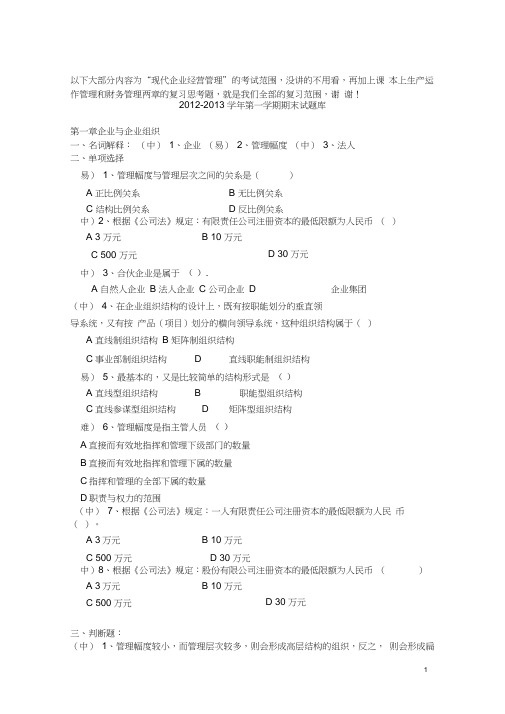
以下大部分内容为“现代企业经营管理”的考试范围,没讲的不用看,再加上课 本上生产运作管理和财务管理两章的复习思考题,就是我们全部的复习范围,谢 谢!2012-2013 学年第一学期期末试题库 第一章企业与企业组织一、名词解释: (中) 1、企业 (易) 2、管理幅度 (中) 3、法人 二、单项选择易) 1、管理幅度与管理层次之间的关系是()A 正比例关系B 无比例关系C 结构比例关系D 反比例关系中)2、根据《公司法》规定:有限责任公司注册资本的最低限额为人民币 ( ) A 3 万元 B 10 万元D 30 万元中) 3、合伙企业是属于 ( ).A 自然人企业B 法人企业C 公司企业 D(中) 4、在企业组织结构的设计上,既有按职能划分的垂直领导系统,又有按 产品(项目)划分的横向领导系统,这种组织结构属于( )A 直线制组织结构B 矩阵制组织结构C 事业部制组织结构D直线职能制组织结构易) 5、最基本的,又是比较简单的结构形式是 ( )A 直线型组织结构B 职能型组织结构C 直线参谋型组织结构D矩阵型组织结构难) 6、管理幅度是指主管人员 ( )A 直接而有效地指挥和管理下级部门的数量B 直接而有效地指挥和管理下属的数量C 指挥和管理的全部下属的数量D 职责与权力的范围(中) 7、根据《公司法》规定:一人有限责任公司注册资本的最低限额为人民 币( )。
A 3万元B 10 万元C 500 万元D 30 万元中)8、根据《公司法》规定:股份有限公司注册资本的最低限额为人民币 ( )A 3万元B 10 万元D 30 万元三、判断题:(中) 1、管理幅度较小,而管理层次较多,则会形成高层结构的组织,反之, 则会形成扁C 500 万元企业集团C 500 万元平结构的组织。
()(易)2、在组织成员一定的条件下,管理层次和管理幅度的关系是反比关系。
()(中)3、个体企业和合伙制企业具有法人资格。
()四、简答题(易)1、企业是由哪些基本要素构成的?(易)2、企业组织结构的基本类型主要有哪些?(易)3、部门划分的原则有哪些?第一章企业与企业组织答案一、名词解释:1、企业:指集合着各种生产要素,为社会提供产品或服务(1 分),以盈利为目的,具有法人资格(1 分),实行自主经营,自负盈亏、独立核算的盈利性(1 分)的经济组织或经济实体。
(完整word版)跨国公司经营与管理参考答案答案

参考答案1、跨国公司对世界、对母国、对东道国的影响?1.对整个世界的影响(1)跨国公司推动资本、技术、人员在全球范围内的优化组合,提高了资源配置的效率;(2)跨国公司推动国际贸易的发展; (3)跨国公司提高消费者的生活品质; (4)跨国公司推动各种文明之间的交流;(5)跨国公司是全球经济增长的引擎,并且,加速了全球化的进程。
2.对母国的影响利益:(1)提高技术成果的产出;(2)获取自然资源和原材料;(3)获取创造性资产;(4) 推动产业结构的优化升级。
危害:(1)加快成熟产业的衰退,可能造成产业空心化;(2)可能加剧本国的失业。
3.对东道国的影响:利益:(1)获得建设资金;(2)有助于接触国外的先进技术和管理经验;(3)解决就业问题;(4)促进对外贸易的发展。
危害:(1)加剧污染;(2)自然资源可能被掠夺性开发;(3)危害产业安全。
2、跨国公司管理与国内公司管理有何联系和区别?1.相同点:自然属性2.不同点:(1)环境异质性;(2)潜在市场规模更大。
3.垄断优势理论的主要观点有哪些?有何理论贡献与不足?主要观点:(1)竞争市场和特定优势的存在是企业对外直接投资的前提;(2)如果产品市场和要素市场是完全竞争的,那么,企业没有必要对外直接投资;(3)如果企业没有特定优势,那么,企业没有能力进行对外直接投资;(4)企业必须依靠特定优势,以克服国外劣势,在东道国取得竞争优势。
贡献:区分了直接投资和间接投资,首次正式地提出了国际直接投资理论。
不足:(1)无法完整解释发展中国家企业的对外直接投资。
(2)优势的跨国转移经常困难重重。
(3)建立在时间压缩不经济性基础上的能力很难被模仿、移植。
(4)具有社会复杂性的资源较难转移、培育。
4、内部化理论的主要观点、理论贡献与不足?主要观点:中间产品市场上的不完全竞争,是导致企业内部化的根本原因。
这些中间产品,不只是半成品、原材料,更为重要的是专利、专用技术、商标、商誉、管理技能和市场信息等知识产品。
企业管理的基本知识考试题及答案
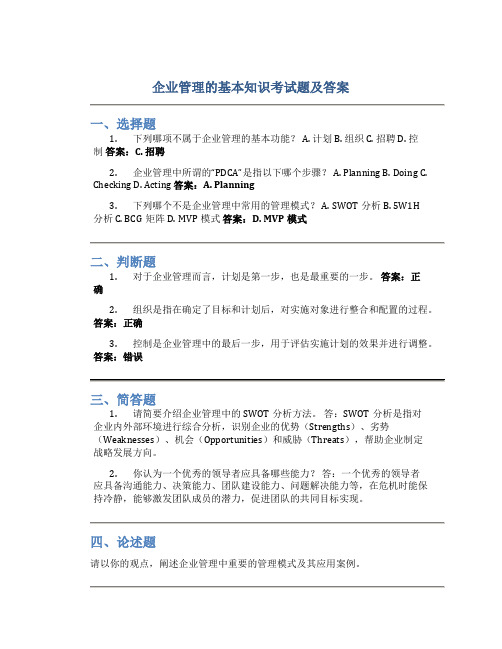
企业管理的基本知识考试题及答案
一、选择题
1.下列哪项不属于企业管理的基本功能? A. 计划 B. 组织 C. 招聘 D. 控
制答案:C. 招聘
2.企业管理中所谓的“PDCA”是指以下哪个步骤? A. Planning B. Doing C. Checking D. Acting 答案:A. Planning
3.下列哪个不是企业管理中常用的管理模式? A. SWOT分析 B. 5W1H
分析 C. BCG矩阵 D. MVP模式答案:D. MVP模式
二、判断题
1.对于企业管理而言,计划是第一步,也是最重要的一步。
答案:正
确
2.组织是指在确定了目标和计划后,对实施对象进行整合和配置的过程。
答案:正确
3.控制是企业管理中的最后一步,用于评估实施计划的效果并进行调整。
答案:错误
三、简答题
1.请简要介绍企业管理中的SWOT分析方法。
答:SWOT分析是指对
企业内外部环境进行综合分析,识别企业的优势(Strengths)、劣势(Weaknesses)、机会(Opportunities)和威胁(Threats),帮助企业制定
战略发展方向。
2.你认为一个优秀的领导者应具备哪些能力?答:一个优秀的领导者
应具备沟通能力、决策能力、团队建设能力、问题解决能力等,在危机时能保持冷静,能够激发团队成员的潜力,促进团队的共同目标实现。
四、论述题
请以你的观点,阐述企业管理中重要的管理模式及其应用案例。
以上是企业管理的基本知识考试题及答案,希望能帮助大家更好地理解企业管理的概念和实践。
(完整word版)管理学基础第二版方振邦课后习题答案1-15章

(完整word版)管理学基础第二版方振邦课后习题答案1-15章第1章管理与管理学1、什么是组织?组织的基本特征有哪些?组织:组织是一切管理活动的载体,是由人们组成的、具有明确目的和系统性结构的实体。
具有三种共同的特征,首先,每个组织都是由两个以上的人员组成的。
其次,每个组织都是有一个明确的目的。
最后,每个组织都具有系统性的结构,用以规范和限制成员的行为。
2、如何理解管理的内涵管理的概念:本书将管理定义为一个协调工作活动的过程,以便能够有效率和有效果地同别人一起或通过别人实现组织的目标。
(1)管理是一个协调工作的过程,这个过程代表了一系列进行中的有管理者参与的职能活动;(2)管理是与他人一起或通过他人实现组织的目标,这就区分了管理岗位和非管理岗位;(3)效率和效果是管理活动追求的两大目标。
效率(efficiency)是指以尽可能少的投入获得尽可能多的产出;效果(effect)是指所从事的工作和活动有助于组织达到其目标。
可见效率是关于做事的方式,而效果涉及结果。
3、论述管理的性质及其一般特征管理的性质:1.管理的自然属性和社会属性。
2.现代管理的科学性和艺术性。
管理的一般特征:1。
管理最基本的任务是实现有效的社会协作。
2. 管理最基本的形式是组织。
3。
管理最主要的内容是处理人际关系。
4。
管理发展的主要动力是变革与创新。
4、简述管理者在组织中扮演的角色1.人际关系。
管理者在人际关系方面的角色有三种,分别是挂名首脑、领导者和联络者.2.信息传递。
在组织的信息传递过程中,管理者也就成了组织中的信息监听者、传播者和发言人。
3.决策制定。
决策制定是做出抉择的活动,管理者扮演着包括企业家、混乱驾驭者、资源分配者和谈判者四种角色。
5、简述管理的环境。
管理的环境:是指能够对管理活动的成效产生潜在影响的何种因素的总和,可以将其划分为内部环境和外部环境.6、如何对管理的外部环境进行评估和管理根据外部环境的特点和客观形势的变换采取相应的技术和方法对其进行评估与管理.(1)评估环境就是评估其不确定性程度。
企业信息管理网上第一次作业-答案Word版

1. 表达概念模型最常用的工具是()。
A. C/S系统结构图B. B/S系统结构图C. 鱼骨图D. E-R图满分:2 分2. 下列哪项属于企业运用信息系统有助于抗击买方的竞争作用力()。
A. 改进产品性能B. 寻找潜在供应商C. 提高转换成本D. "进入壁垒"满分:2 分3. 下列哪项属于企业运用信息系统有助于抗击供方的竞争作用力()。
A. "进入壁垒B. 寻找潜在供应商C. 提高转换成本D. 改进产品性能满分:2 分4. 网络拓扑结构中,结构简单,容易安装,易于扩充的是()。
A. 总线形结构B. 星形结构C. 环形结构D. 树形结构满分:2 分5. 网络拓扑结构中,中心结点对全网的通信实行集中控制,这属于()。
A. 线形结构B. 星形结构C. 环形结构D. 树形结构满分:2 分6. 以下哪个不是描述信息内容方面的价值属性。
( )A. 正确性B. 相关性C. 完整性D. 层次性满分:2 分7. 关系模型中,元组也被称为()。
A. 外链B. 记录C. 主链D. 外码满分:2 分8. 在网络的拓扑结构中,适合采用光纤的是()。
A. 星形B. 树形C. 总线形D. 环形满分:2 分9. 关系模型中,主码也被称为()。
A. 外链B. 域C. 主链D. 外码满分:2 分10. 数据库设计的基本原则是()。
A. 简单性、非冗余性B. 复杂性、非冗余性C. 简单性、冗余性D. 复杂性、冗余性二、多项选择题(共20 道试题,共60 分。
)1. 数据库管理系统的功能有()。
A. 数据库的定义功能B. 数据库的操纵功能C. 数据库的更新功能D. 数据库的维护功能满分:3 分2. 信息内容方面的价值属性包括()。
A. 正确性B. 控制性C. 完整性D. 层次性满分:3 分3. 按决策层次分类,管理信息可分为()。
A. 战略信息B. 战术信息C. 内源信息D. 业务信息满分:3 分4. 因特网的基本服务包括()。
(完整word版)国际财务管理(英文版)课后习题答案8
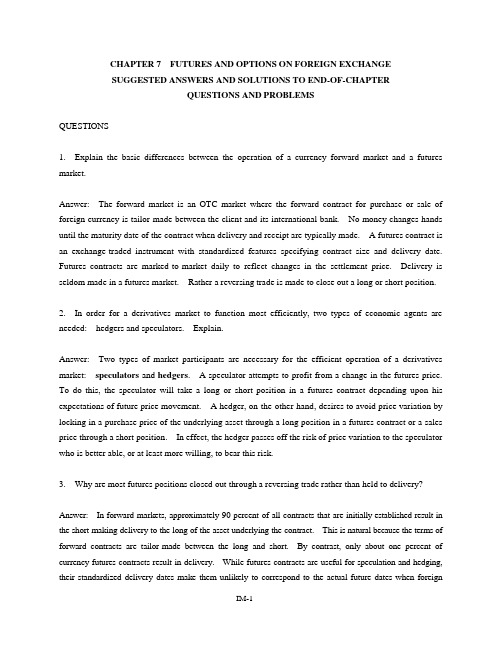
CHAPTER 7 FUTURES AND OPTIONS ON FOREIGN EXCHANGESUGGESTED ANSWERS AND SOLUTIONS TO END-OF-CHAPTERQUESTIONS AND PROBLEMSQUESTIONS1. Explain the basic differences between the operation of a currency forward market and a futures market.Answer: The forward market is an OTC market where the forward contract for purchase or sale of foreign currency is tailor-made between the client and its international bank. No money changes hands until the maturity date of the contract when delivery and receipt are typically made. A futures contract is an exchange-traded instrument with standardized features specifying contract size and delivery date. Futures contracts are marked-to-market daily to reflect changes in the settlement price. Delivery is seldom made in a futures market. Rather a reversing trade is made to close out a long or short position.2. In order for a derivatives market to function most efficiently, two types of economic agents are needed: hedgers and speculators. Explain.Answer: Two types of market participants are necessary for the efficient operation of a derivatives market: speculators and hedgers. A speculator attempts to profit from a change in the futures price. To do this, the speculator will take a long or short position in a futures contract depending upon his expectations of future price movement. A hedger, on-the-other-hand, desires to avoid price variation by locking in a purchase price of the underlying asset through a long position in a futures contract or a sales price through a short position. In effect, the hedger passes off the risk of price variation to the speculator who is better able, or at least more willing, to bear this risk.3. Why are most futures positions closed out through a reversing trade rather than held to delivery?Answer: In forward markets, approximately 90 percent of all contracts that are initially established result in the short making delivery to the long of the asset underlying the contract. This is natural because the terms of forward contracts are tailor-made between the long and short. By contrast, only about one percent of currency futures contracts result in delivery. While futures contracts are useful for speculation and hedging, their standardized delivery dates make them unlikely to correspond to the actual future dates when foreignexchange transactions will occur. Thus, they are generally closed out in a reversing trade. In fact, the commission that buyers and sellers pay to transact in the futures market is a single amount that covers the round-trip transactions of initiating and closing out the position.4. How can the FX futures market be used for price discovery?Answer: To the extent that FX forward prices are an unbiased predictor of future spot exchange rates, the market anticipates whether one currency will appreciate or depreciate versus another. Because FX futures contracts trade in an expiration cycle, different contracts expire at different periodic dates into the future. The pattern of the prices of these cont racts provides information as to the market’s current belief about the relative future value of one currency versus another at the scheduled expiration dates of the contracts. One will generally see a steadily appreciating or depreciating pattern; however, it may be mixed at times. Thus, the futures market is useful for price discovery, i.e., obtaining the market’s forecast of the spot exchange rate at different future dates.5. What is the major difference in the obligation of one with a long position in a futures (or forward) contract in comparison to an options contract?Answer: A futures (or forward) contract is a vehicle for buying or selling a stated amount of foreign exchange at a stated price per unit at a specified time in the future. If the long holds the contract to the delivery date, he pays the effective contractual futures (or forward) price, regardless of whether it is an advantageous price in comparison to the spot price at the delivery date. By contrast, an option is a contract giving the long the right to buy or sell a given quantity of an asset at a specified price at some time in the future, but not enforcing any obligation on him if the spot price is more favorable than the exercise price. Because the option owner does not have to exercise the option if it is to his disadvantage, the option has a price, or premium, whereas no price is paid at inception to enter into a futures (or forward) contract.6. What is meant by the terminology that an option is in-, at-, or out-of-the-money?Answer: A call (put) option with S t > E (E > S t) is referred to as trading in-the-money. If S t E the option is trading at-the-money. If S t< E (E < S t) the call (put) option is trading out-of-the-money.7. List the arguments (variables) of which an FX call or put option model price is a function. How does the call and put premium change with respect to a change in the arguments?Answer: Both call and put options are functions of only six variables: S t, E, r i, r$, T andσ.When all else remains the same, the price of a European FX call (put) option will increase:1. the larger (smaller) is S,2. the smaller (larger) is E,3. the smaller (larger) is r i,4. the larger (smaller) is r$,5. the larger (smaller) r$ is relative to r i, and6. the greater is σ.When r$ and r i are not too much different in size, a European FX call and put will increase in price when the option term-to-maturity increases. However, when r$ is very much larger than r i, a European FX call will increase in price, but the put premium will decrease, when the option term-to-maturity increases. The opposite is true when r i is very much greater than r$. For American FX options the analysis is less complicated. Since a longer term American option can be exercised on any date that a shorter term option can be exercised, or a some later date, it follows that the all else remaining the same, the longer term American option will sell at a price at least as large as the shorter term option.PROBLEMS1. Assume today’s settlement price on a CME EUR futures contract is $1.3140/EUR. You have a short position in one contract. Your performance bond account currently has a balance of $1,700. The next three days’ settlement prices are $1.3126, $1.3133, and $1.3049. Calculate the chan ges in the performance bond account from daily marking-to-market and the balance of the performance bond account after the third day.Solution: $1,700 + [($1.3140 - $1.3126) + ($1.3126 - $1.3133)+ ($1.3133 - $1.3049)] x EUR125,000 = $2,837.50,where EUR125,000 is the contractual size of one EUR contract.2. Do problem 1 again assuming you have a long position in the futures contract.Solution: $1,700 + [($1.3126 - $1.3140) + ($1.3133 - $1.3126) + ($1.3049 - $1.3133)] x EUR125,000 = $562.50,where EUR125,000 is the contractual size of one EUR contract.With only $562.50 in your performance bond account, you would experience a margin call requesting that additional funds be added to your performance bond account to bring the balance back up to the initial performance bond level.3. Using the quotations in Exhibit 7.3, calculate the face value of the open interest in the June 2005 Swiss franc futures contract.Solution: 2,101 contracts x SF125,000 = SF262,625,000.where SF125,000 is the contractual size of one SF contract.4. Using the quotations in Exhibit 7.3, note that the June 2005 Mexican peso futures contract has a price of $0.08845. You believe the spot price in June will be $0.09500. What speculative position would you enter into to attempt to profit from your beliefs? Calculate your anticipated profits, assuming you take a position in three contracts. What is the size of your profit (loss) if the futures price is indeed an unbiased predictor of the future spot price and this price materializes?Solution: If you expect the Mexican peso to rise from $0.08845 to $0.09500, you would take a long position in futures since the futures price of $0.08845 is less than your expected spot price.Your anticipated profit from a long position in three contracts is: 3 x ($0.09500 - $0.08845) x MP500,000 = $9,825.00, where MP500,000 is the contractual size of one MP contract.If the futures price is an unbiased predictor of the expected spot price, the expected spot price is the futures price of $0.08845/MP. If this spot price materializes, you will not have any profits or losses from your short position in three futures contracts: 3 x ($0.08845 - $0.08845) x MP500,000 = 0.5. Do problem 4 again assuming you believe the June 2005 spot price will be $0.08500.Solution: If you expect the Mexican peso to depreciate from $0.08845 to $0.07500, you would take a short position in futures since the futures price of $0.08845 is greater than your expected spot price.Your anticipated profit from a short position in three contracts is: 3 x ($0.08845 - $0.07500) x MP500,000 = $20,175.00.If the futures price is an unbiased predictor of the future spot price and this price materializes, you will not profit or lose from your long futures position.6. George Johnson is considering a possible six-month $100 million LIBOR-based, floating-rate bank loan to fund a project at terms shown in the table below. Johnson fears a possible rise in the LIBOR rate by December and wants to use the December Eurodollar futures contract to hedge this risk. The contract expires December 20, 1999, has a US$ 1 million contract size, and a discount yield of7.3 percent.Johnson will ignore the cash flow implications of marking to market, initial margin requirements, and any timing mismatch between exchange-traded futures contract cash flows and the interest payments due in March.Loan TermsSeptember 20, 1999 December 20, 1999 March 20, 2000 •Borrow $100 million at •Pay interest for first three •Pay back principal September 20 LIBOR + 200 months plus interestbasis points (bps) •Roll loan over at•September 20 LIBOR = 7% December 20 LIBOR +200 bpsLoan First loan payment (9%) Second paymentinitiated and futures contract expires and principal↓↓↓•••9/20/99 12/20/99 3/20/00a. Formulate Johnson’s September 20 floating-to-fixed-rate strategy using the Eurodollar future contracts discussed in the text above. Show that this strategy would result in a fixed-rate loan, assuming an increase in the LIBOR rate to 7.8 percent by December 20, which remains at 7.8 percent through March 20. Show all calculations.Johnson is considering a 12-month loan as an alternative. This approach will result in two additional uncertain cash flows, as follows:Loan First Second Third Fourth payment initiated payment (9%) payment payment and principal ↓↓↓↓↓•••••9/20/99 12/20/99 3/20/00 6/20/00 9/20/00 b. Describe the strip hedge that Johnson could use and explain how it hedges the 12-month loan (specify number of contracts). No calculations are needed.CFA Guideline Answera. The basis point value (BPV) of a Eurodollar futures contract can be found by substituting the contract specifications into the following money market relationship:BPV FUT = Change in Value = (face value) x (days to maturity / 360) x (change in yield)= ($1 million) x (90 / 360) x (.0001)= $25The number of contract, N, can be found by:N = (BPV spot) / (BPV futures)= ($2,500) / ($25)= 100ORN = (value of spot position) / (face value of each futures contract)= ($100 million) / ($1 million)= 100ORN = (value of spot position) / (value of futures position)= ($100,000,000) / ($981,750)where value of futures position = $1,000,000 x [1 – (0.073 / 4)]102 contractsTherefore on September 20, Johnson would sell 100 (or 102) December Eurodollar futures contracts at the 7.3 percent yield. The implied LIBOR rate in December is 7.3 percent as indicated by the December Eurofutures discount yield of 7.3 percent. Thus a borrowing rate of 9.3 percent (7.3 percent + 200 basis points) can be locked in if the hedge is correctly implemented.A rise in the rate to 7.8 percent represents a 50 basis point (bp) increase over the implied LIBOR rate. For a 50 basis point increase in LIBOR, the cash flow on the short futures position is:= ($25 per basis point per contract) x 50 bp x 100 contracts= $125,000.However, the cash flow on the floating rate liability is:= -0.098 x ($100,000,000 / 4)= - $2,450,000.Combining the cash flow from the hedge with the cash flow from the loan results in a net outflow of $2,325,000, which translates into an annual rate of 9.3 percent:= ($2,325,000 x 4) / $100,000,000 = 0.093This is precisely the implied borrowing rate that Johnson locked in on September 20. Regardless of the LIBOR rate on December 20, the net cash outflow will be $2,325,000, which translates into an annualized rate of 9.3 percent. Consequently, the floating rate liability has been converted to a fixed rate liability in the sense that the interest rate uncertainty associated with the March 20 payment (using the December 20 contract) has been removed as of September 20.b. In a strip hedge, Johnson would sell 100 December futures (for the March payment), 100 March futures (for the June payment), and 100 June futures (for the September payment). The objective is to hedge each interest rate payment separately using the appropriate number of contracts. The problem is the same as in Part A except here three cash flows are subject to rising rates and a strip of futures is used tohedge this interest rate risk. This problem is simplified somewhat because the cash flow mismatch between the futures and the loan payment is ignored. Therefore, in order to hedge each cash flow, Johnson simply sells 100 contracts for each payment. The strip hedge transforms the floating rate loan into a strip of fixed rate payments. As was done in Part A, the fixed rates are found by adding 200 basis points to the implied forward LIBOR rate indicated by the discount yield of the three different Eurodollar futures contracts. The fixed payments will be equal when the LIBOR term structure is flat for the first year.7. Jacob Bower has a liability that:•has a principal balance of $100 million on June 30, 1998,•accrues interest quarterly starting on June 30, 1998,•pays interest quarterly,•has a one-year term to maturity, and•calculates interest due based on 90-day LIBOR (the London Interbank OfferedRate).Bower wishes to hedge his remaining interest payments against changes in interest rates.Bower has correctly calculated that he needs to sell (short) 300 Eurodollar futures contracts to accomplish the hedge. He is considering the alternative hedging strategies outlined in the following table.Initial Position (6/30/98) in90-Day LIBOR Eurodollar ContractsStrategy A Strategy BContract Month (contracts) (contracts)September 1998 300 100December 1998 0 100March 1999 0 100a. Explain why strategy B is a more effective hedge than strategy A when the yield curveundergoes an instantaneous nonparallel shift.b. Discuss an interest rate scenario in which strategy A would be superior to strategy B.CFA Guideline Answera. Strategy B’s SuperiorityStrategy B is a strip hedge that is constructed by selling (shorting) 100 futures contracts maturing in each of the next three quarters. With the strip hedge in place, each quarter of the coming year is hedged against shifts in interest rates for that quarter. The reason Strategy B will be a more effective hedge than Strategy A for Jacob Bower is that Strategy B is likely to work well whether a parallel shift or a nonparallel shift occurs over the one-year term of Bower’s liability. That is, regardless of what happens to the term structure, Strategy B structures the futures hedge so that the rates reflected by the Eurodollar futures cash price match the applicable rates for the underlying liability-the 90day LIBOR-based rate on Bower’s liability. The same is not true for Strategy A. Because Jacob Bower’s liability carries a floating interest rate that resets quarterly, he needs a strategy that provides a series of three-month hedges. Strategy A will need to be restructured when the three-month September contract expires. In particular, if the yield curve twists upward (futures yields rise more for distant expirations than for near expirations), Strategy A will produce inferior hedge results.b. Scenario in Which Strategy A is SuperiorStrategy A is a stack hedge strategy that initially involves selling (shorting) 300 September contracts. Strategy A is rarely better than Strategy B as a hedging or risk-reduction strategy. Only from the perspective of favorable cash flows is Strategy A better than Strategy B. Such cash flows occur only in certain interest rate scenarios. For example Strategy A will work as well as Strategy B for Bower’s liability if interest rates (instantaneously) change in parallel fashion. Another interest rate scenario where Strategy A outperforms Strategy B is one in which the yield curve rises but with a twist so that futures yields rise more for near expirations than for distant expirations. Upon expiration of the September contract, Bower will have to roll out his hedge by selling 200 December contracts to hedge the remaining interest payments. This action will have the effect that the cash flow from Strategy A will be larger than the cash flow from Strategy B because the appreciation on the 300 short September futures contracts will be larger than the cumulative appreciation in the 300 contracts shorted in Strategy B (i.e., 100 September, 100 December, and 100 March). Consequently, the cash flow from Strategy A will more than offset the increase in the interest payment on the liability, whereas the cash flow from Strategy B will exactly offset the increase in the interest payment on the liability.8. Use the quotations in Exhibit 7.7 to calculate the intrinsic value and the time value of the 97 September Japanese yen American call and put options.Solution: Premium - Intrinsic Value = Time Value97 Sep Call 2.08 - Max[95.80 – 97.00 = - 1.20, 0] = 2.08 cents per 100 yen97 Sep Put 2.47 - Max[97.00 – 95.80 = 1.20, 0] = 1.27 cents per 100 yen9. Assume spot Swiss franc is $0.7000 and the six-month forward rate is $0.6950. What is the minimum price that a six-month American call option with a striking price of $0.6800 should sell for in a rational market? Assume the annualized six-month Eurodollar rate is 3 ½ percent.Solution:Note to Instructor: A complete solution to this problem relies on the boundary expressions presented in footnote 3 of the text of Chapter 7.C a≥Max[(70 - 68), (69.50 - 68)/(1.0175), 0]≥Max[ 2, 1.47, 0] = 2 cents10. Do problem 9 again assuming an American put option instead of a call option.Solution: P a≥Max[(68 - 70), (68 - 69.50)/(1.0175), 0]≥Max[ -2, -1.47, 0] = 0 cents11. Use the European option-pricing models developed in the chapter to value the call of problem 9 and the put of problem 10. Assume the annualized volatility of the Swiss franc is 14.2 percent. This problem can be solved using the FXOPM.xls spreadsheet.Solution:d1 = [ln(69.50/68) + .5(.142)2(.50)]/(.142)√.50 = .2675d2 = d1 - .142√.50 = .2765 - .1004 = .1671N(d1) = .6055N(d2) = .5664N(-d1) = .3945N(-d2) = .4336C e = [69.50(.6055) - 68(.5664)]e-(.035)(.50) = 3.51 centsP e = [68(.4336) - 69.50(.3945)]e-(.035)(.50) = 2.03 cents12. Use the binomial option-pricing model developed in the chapter to value the call of problem 9.The volatility of the Swiss franc is 14.2 percent.Solution: The spot rate at T will be either 77.39¢ = 70.00¢(1.1056) or 63.32¢ = 70.00¢(.9045), where u = e.142 .50= 1.1056 and d = 1/u= .9045. At the exercise price of E= 68, the option will only be exercised at time T if the Swiss franc appreciates; its exercise value would be C uT= 9.39¢ = 77.39¢ - 68. If the Swiss franc depreciates it would not be rational to exercise the option; its value would be C dT = 0.The hedge ratio is h = (9.39 – 0)/(77.39 – 63.32) = .6674.Thus, the call premium is:C0= Max{[69.50(.6674) – 68((70/68)(.6674 – 1) +1)]/(1.0175), 70 – 68}= Max[1.64, 2] = 2 cents per SF.MINI CASE: THE OPTIONS SPECULATORA speculator is considering the purchase of five three-month Japanese yen call options with a striking price of 96 cents per 100 yen. The premium is 1.35 cents per 100 yen. The spot price is 95.28 cents per 100 yen and the 90-day forward rate is 95.71 cents. The speculator believes the yen will appreciate to $1.00 per 100 yen over the next three months. As the speculator’s assistant, you have been asked to prepare the following:1. Graph the call option cash flow schedule.2. Determine the speculator’s profit if the yen appreciates to $1.00/100 yen.3. Determine the speculator’s profit if the yen only appreciates to the forward rate.4. Determine the future spot price at which the speculator will only break even.Suggested Solution to the Options Speculator:1.2. (5 x ¥6,250,000) x [(100 - 96) - 1.35]/10000 = $8,281.25.3. Since the option expires out-of-the-money, the speculator will let the option expire worthless. He will only lose the option premium.4. S T = E + C = 96 + 1.35 = 97.35 cents per 100 yen.。
(完整word版)管理学原理 简答题论述题及答案

41.简述管理过程学派的基本观点。
答:(1)管理是一个过程,即让别人和自己去实现既定目标的过程。
(2)管理过程的职能有五个,即计划工作,组织工作,人员配备,指挥(指导与领导)和控制.(3)管理职能具有普遍性.(4)管理应具有灵活性。
42.简述决策的程序。
答:(1)确定决策目标,拟定备选方案.(2)评价备选方案。
(3)选择方案.43.简述组织工作的步骤。
答:组织工作的步骤包括六步:(1)确定组织目标。
(2)对目标进行分解,拟定派生目标.(3)确认为实现目标所必须的各项业务工作,并加以分类。
(4)根据可利用的人力、物力、以及利用它们的最好方法来划分各种工作,由此形成部门。
(5)将进行业务活动所必须的职权授予各部门的负责人,由此形成职务说明书,规定该职务的职责和权限。
(6)通过职权关系和信息系统,把各部分的业务活动上下左右紧密地联系起来。
44.简述计划工作的步骤。
答:计划工作的步骤包括以下八点:(1)估量机会。
(2)确定目标。
(3)确定前提。
(4)确定可供选择的方案。
(5)评价各种方案.(6)选择方案。
(7)制定派生计划.(8)用预算形式使计划数字化。
45.试论人员配备工作在管理五大职能中的地位作用及其重要性.答:(1)管理中的人员配备是指对主管人员进行恰当而有效地选拔、培训和考评。
其目的在于配备合适的人员去充实组织结构中所规定的各种职务,保证组织活动的正常进行,实现组织目标。
(2)人员配备是管理的五大职能之一,与其他职能存在着密切的联系:目标与计划是组织工作的依据,组织结构决定了所需主管人员的数量和种类;适当的人员配备有利于做好指导和领导工作;选拔优秀的主管人员也会促进控制工作;人员配备工作要采用开放的方法,不仅从组织内部,也通过环境把各项管理职能有机地联系起来。
(3)人员配备工作的重要性体现在:首先它是组织有效活动的保证;人是实现组织目标最重要的资源,主管人员在组织中起着举足轻重的作用.其次,人员配备是组织发展的准备。
公司安全培训试题word版
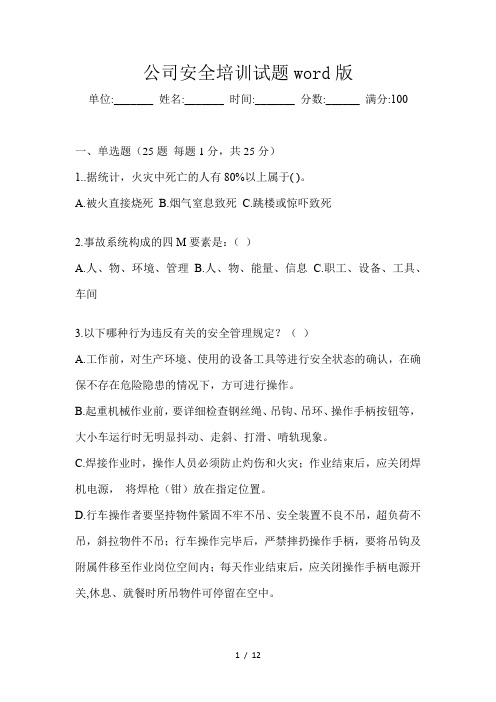
公司安全培训试题word版单位:_______ 姓名:_______ 时间:_______ 分数:______ 满分:100一、单选题(25题每题1分,共25分)1..据统计,火灾中死亡的人有80%以上属于( )。
A.被火直接烧死B.烟气窒息致死C.跳楼或惊吓致死2.事故系统构成的四M要素是:()A.人、物、环境、管理B.人、物、能量、信息C.职工、设备、工具、车间3.以下哪种行为违反有关的安全管理规定?()A.工作前,对生产环境、使用的设备工具等进行安全状态的确认,在确保不存在危险隐患的情况下,方可进行操作。
B.起重机械作业前,要详细检查钢丝绳、吊钩、吊环、操作手柄按钮等,大小车运行时无明显抖动、走斜、打滑、啃轨现象。
C.焊接作业时,操作人员必须防止灼伤和火灾;作业结束后,应关闭焊机电源,将焊枪(钳)放在指定位置。
D.行车操作者要坚持物件紧固不牢不吊、安全装置不良不吊,超负荷不吊,斜拉物件不吊;行车操作完毕后,严禁摔扔操作手柄,要将吊钩及附属件移至作业岗位空间内;每天作业结束后,应关闭操作手柄电源开关,休息、就餐时所吊物件可停留在空中。
4.某小区主排水管道发生堵塞,S物业公司委托W管道工程公司实施新建污水井与原有污水管线连通作业。
W管道工程公司作业班长甲某,在未采取有效安全措施的情况下,贸然下井对原有污水管线进行开孔作业,突然被熏倒,从原有污水管线上跌至井底(落差2m,井口到井底共3.8m),乙某第一时间对甲某进行施救。
下列关于应急处罝的做法中,正确的是( )。
A.乙某拴挂安全绳后被迅速吊至井底,将甲某提升至地面B.乙某拴挂安全绳,佩戴防毒面具后下井将甲某提升至地面C.乙某拴挂安全绳,佩戴空气呼吸器后下井将甲某提升至地面D.乙某佩戴防护装备并在三脚架架设完成后下井将甲某提升至地面5.生产安全事故分为()、重伤事故A.轻伤事故B.一般事故C.严重事故D.经济事故6.法人单位的()或者非法人单位的主要负责人是本单位的消防安全责任人,对本单位的消防安全工作全面负责。
- 1、下载文档前请自行甄别文档内容的完整性,平台不提供额外的编辑、内容补充、找答案等附加服务。
- 2、"仅部分预览"的文档,不可在线预览部分如存在完整性等问题,可反馈申请退款(可完整预览的文档不适用该条件!)。
- 3、如文档侵犯您的权益,请联系客服反馈,我们会尽快为您处理(人工客服工作时间:9:00-18:30)。
一、判断题C.产品特点和生产技术复杂程度越高,集权程度也就越低。
×C.传统人力资本理论认为,只有个人的知识、技能和体力才对财富起作用。
√C:产品特点和生产技术复杂程度越高,集权程度也就越高。
√D 当企业开展国际化经营时,会遇到贸易壁垒和其他市场不完全的限制,从而增加外部交易成本√D. 对外直接投资是指在国外开办企业的投资活动。
√D.独资企业的含义是它的所有权全部属于投资者,投资者提供全部资金,独立经营,获利。
√D.对外直接投资,是指企业在国外进行的以控制企业经营管理权为核心,以获取利润为。
√F.分包是指一家企业将一具体的生产任务或将企业某一经营部门承包给另一家公司。
√G. 国际经济一体化实质是资本的本土化。
×G. 国际经济一体化实质是资本的国际化。
√G. 国际企业促进东道国对外贸易的发展。
√G. 国际企业对母国经济和东道国经济的影响,既有积极的一面,也有消极的一面。
√G. 国际企业在深化国际分工过程中起着重要的推动作用。
√G.国际避税是采用选择合适的经营地点和经营方式等种种不合法手段×G.国际分销渠道指的是产品从一国生产企业到达国外最终购买者所经过的机构。
×G.国际企业的经营活动既要承担自然风险、经济风险,还要承担政治法律风险。
√G.国际企业的经营活动只承担自然风险和经济风险。
×G.国际企业劳动力的管理,主要是指对管理人员的管理。
×G.国际企业战略控制的内容是总资源配置和重大经营决策。
√G.国际生产系统设计的指导思想的核心是选择标准化还是差别化的问题。
√G.国际市场上常见的策略有:差别定价、心理定价、新产品定价和价格调整。
√G.国际双重征税是指两个国家对同一,同时按他国税法课征所得税。
×G: 国际双重征税是指两个国家对同一,同时按他本国税法课征所得税√G:国际避税是采用选择合适的经营地点和经营方式等种种合法手段√G:国际分销渠道指的是产品从一国生产企业到达国外最终购买者所经过的各种环节和途径。
√G:国际企业劳动力的管理,主要是指对工人的管理。
√J. 间接投资是指在国外开办企业的投资活动。
×J.技术环境对于企业的影响表现在技术革命所带来的产业革新。
√J.进入国际市场的产品同样经历投入期、成长期、成熟期和衰退期。
√J.经济环境对企业国际经营的影响在所有的经营环境中最直接。
√J.经济学家预言:信息技术的发展会使组织发生巨大变化√K.跨国界的内部资金调配是国际企业财务管理与普通国内企业√N 内部化优势是指企业拥有或掌握某种财产权和无形资产的优势×N内部化优势是指拥有所有权优势企业通过扩大自己的组织和经营活动将这些优势的利用内部化的能力√Q.企业规模越大,子公司的经营自主权也要相对扩大。
√S 所有权优势是指企业拥有或掌握某种财产权和无形资产的优势√S.社会文化环境可以说是无影无形,但又无处不在。
√S.收入水平是决定消费需求的基本因素。
√T. 特许经营是许可证贸易的一种变体,前者则支付一定金额的特许费。
×T:特许经营是许可证贸易的一种变体,后者则支付一定金额的特许费。
√W.外汇期权是外汇期权交易双方按照协定的汇率,就将来是否购买某√W.网络组织结构是工业时代的代表性组织结构×W:网络组织结构是信息时代的代表性组织结构√X 小岛清认为,产品出口战略是促进国际上生产要素价格均等化的重要因素×X 小岛清认为,对外直接投资是促进国际上生产要素价格均等化的重要因素√X.现代人力资本理论认为,个人的道德素质、信誉、和社会关系也应属于人力资源。
√X.许可证贸易指通过签订许可合同,输出方支付给输入方专利权使用费×X许可证贸易指通过签订许可合同,输入方支付给输出方专利权使用费√Y 英国里丁大学教授邓宁提出了国际投资周期论√Y.一个合格的海外经理人员,必须达到这样的标准:能被国家的民族文化所完全同化×Y.影响国际营销定价的因素只包括成本因素和市场因素。
×Y.有关人力资本理论可分为传统和现代两类。
∨Y:一个合格的海外经理人员,必须达到这样的标准:能被公司的企业文化所完全同化√Y:影响国际营销定价的因素包括成本因素、市场因素、政府政策、法令等。
√Z.在技术输出时应考虑其先进性、投资风险、技术秘密外泄风险、×Z.在技术引进时应考虑其先进性、适用性、可靠性和投资风险。
×Z.在选择国际分销渠道时,要考虑产品、市场、企业本身条件等因素。
√Z.斋藤优教授认为,经济和对外经济活动,受国民需求与资源关系的制约。
√Z.折算风险是由于汇率变动,报表的不同项目采用相同汇率折算。
×Z.著名国际经济学家、英国里丁大学教授邓宁认为:国际技术转移是。
√Z: 折算风险是由于汇率变动,报表的不同项目采用不同汇率折算√Z:在技术输出时应考虑其投资要素、投资风险、技术秘密外泄风险、√Z:在技术引进时应考虑其先进性、适用性、可靠性和经济性。
√二、单项选择题B.(国际事业部结构)比较适合于从事多国性生产不久产品、产品标准化、C采用国际事业部结构较多的是(美国)的公司。
D.(劳动力)的可供性及工资水平是影响国际生产的重要因素。
D.对国际经营人员考评的中心内容为(业绩考评)。
D.对国际企业经营的影响表现得最直接的是(经济环境)D当英国的通货膨胀率比美国高,则(英镑汇价下降)。
G 国际利益分配模型表明,资本的跨国移动会增加(资本输入输出双方国家)的国际利益G.根据本企业专长,生产销路好的产品项目或提供某些特需产品,这是(特殊型)G.构成延伸产品的标志是(附加价值)。
G.国际经济一体化的实质是(资本)G.国际企业的(全球中心型)组织控制体制是集权与分权相结合的管理体制。
G.国际企业各种全球化战略之间的关系是(既相互独立又相互依存)G.国际直接投资是指(生产资本)的国际化G工作丰富化是指给工人更多的(自主权和责任感)。
I.IBM在国外长期推行的是(独资企业)战略。
J.将多向发展产品和多个目标市场结合起来是(多种经营型)产品组合。
J.就(经济环境)而言,各国市场容量的差异是制约生产标准化的重要因素。
M.美国政府支出占GNP的比重的25%,反映了(政治法律环境)对国际企业的影响R 如果企业既具备所有权优势又具备内部化优势和区位优势,就应选择(对外直接投资)R 如果企业只具备所有权优势和内部化优势,就应选择(出口贸易)R 如果企业只具备所有权优势就应选择(技术转让)R.内部转移价格避税是国际企业利用(税率和税法)的差异通过。
R日本非常注重在美国俄国和其他邻国之间维持平衡表明了一国的地理位置可以(政治环境)R如果一国提高利率,那么会出现(该国货币远期汇率下跌)。
S(人力资源)是一切资源中最主要的资源。
S.(经济性)是企业引进技术时需要考虑的最重要的因素S.(社会关系)是人们在社会交往的过程中形成的一种人与人之间的联系。
S.设立财务部、营销部、生产部,各部负责各(全球性职能组织结构)。
S.生产经营空洞化是实施(分包)战略所必须应对的严峻问题。
S.实施(许可证贸易)战略的投资规模小,近年来成为生物技术、S.世界范围内的制成品与提供原料的分工是(垂直式)国际分工T.通货膨胀使(纸币)所代表的实际价值贬低。
X.下列哪种国际化经营活动不享有国外经营管理权(国际租赁)X.下列哪种国际化经营活动享有国外经营管理权(直接投资)X.下列行业中易被没收、征用和国有化的行业是(石油开采)X.下面不属于政治风险的是(当地化)Y (约翰.威廉逊)认为,在开放经济条件下,资本移动对有关国家的经济增长是有Y.以现有产品或市场为基础,利用技术、设备、销售等潜力,扩大是(扩张型)Y.与普通商品的交易不同,技术的转让是(使用权)的转让。
Y影响公司税收的首要因素是(税收制度和税收政策)。
Y与普通商品不同,技术的转让是(使用权)的转让。
Z.(自主子公司结构)是国内企业走向国际企业时在组织方面的一种过渡形式。
Z.在同一产品线内加深产品档次,这是(加深型)。
Z.战略联盟的概念最早是由(简.霍普兰德)提出。
三、多项选择题B.避免双重税的解决办法包括(免税法,抵免法,扣税法,减税法)。
C.产品的整体概念分为(核心产品, 形体产品,延伸产品)。
C.传统人力资本理论认为,在人素质中,只有个人(知识,技能,体力)增值作用。
C.从分工和组织结构看,国际企业可分为(水平型, 垂直型, 混合型)C.促进销售通常包括(广告宣传, 人员推销,营业推广, 公共关系)D.对外直接投资是指企业以(资金, 技术, 设备, 劳务)的方式在国外开办企业F.发达工业国家跨国企业配备人,从(本国,东道国,第三国)挑选国际企业人员。
G 国际企业组织结构设计形式主要有(出口,自主, 国际, 全球)G.构成形式产品的标志是(产品特征, 商标)。
G.国际企业财务必须解决企业财务决策权的(集权,分权)问题。
G.国际企业的间接投资环境包括(自然环境,政治法律环境, 技术与社会文化环境, 经济环境)G.国际企业的经营方式主要有(商品和劳务的进出口, 合同性安排, 间接投资, 直接投资)G.国际企业选择组织形式须考虑的因素是(ABCD)。
G.国际企业战略控制的内容是(总资源配置,重大经营决策)。
G.国际企业组织控制体制可分为(本国, 多元,全球)。
G.国际上通行的合作性协议主要有(许可证贸易, 特许经营, 分包)G.国际营销的定价策略一般常见的有(差别定价, 心理定价, 新产品定价, 价格调整)。
G.国际战略联盟的类型(研究开发, 制造生产, 联合销售, 合资企业)G.国际战略联盟的目的实际上是为了实现国际企业间的(资源共有, 风险共担, 利益共享)G供跨国公司选择的国际采购体制是(中心购买式, 自主购买式, 混合式)。
G国际企业的资金来源的渠道主要有(企业外部,企业内部资金)。
G国际事业部结构的优点是(管理一贯化, 资源的综合调配)。
H 海黙提出的对外直接投资的条件是(市场不完全,垄断优势)J. 交易性人力资本理论包括国民的(信誉,道德素质,社会关系)。
J.基础性人力资本理论包括(知识,技能,体力)。
L 两缺口理论认为,制约发展中国家经济增长的因素是(储蓄,外汇)M.美国国际企业最常用的工作分析方法是(工作分析会谈,工作分析~岗位分析问卷)N 哪三种市场不完全导致企业拥有垄断优势(产品差异,专有技术优势,规模经济优势)Q 区位优势包括(市场空间分布,吸引外资政策)S 所有权优势是指(管理技能,创新能力)S.(没收, 征用, 国有化)是企业国际化经营中面临的最严重的风险S.世界市场由(商品市场, 技术市场, 劳务市场, 金融市场)组成。
S.收入水平的研究需要分析以下指标(国民生产总值, 人均收入, 可自由支配收入)W.外汇风险是指企业的(资产,负债,经营成果)因汇率变动而。
